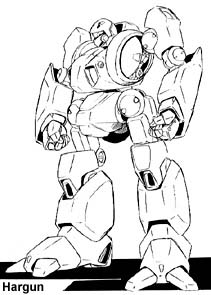
In 2019 as the departure of the Robotech Expeditionary force became immanent and the defense of Earth was beginning to be passed to the Armies of the Southern Cross (ASC), the United Earth Government ordered a number of extensive studies to issue recommendations on the number and type of forces which would be needed in the upcoming decade. After careful consideration, the study concluded that future conflicts were likely between malcontent Zentraedi forces on Earth and the remnants of the Zentraedi fleet attacking from space. To meet the later threat the ASC began to build a space fleet which could defeat any external Zentraedi attack. However, the ASC was not prepared to respond to attacks from within. In 2020, the ASC possessed 25% of the number of ground based mecha which the soon to be departing RDF/REF maintained. As a result, the primary units which would be called on in case of a malcontent rebellion would be conventional in nature supplemented with ground based infantry. Although, the ASC infantry were provided with the most advanced personnel armor available at the time, they were still woefully incapable of stopping an attack from full sized Zentraedi..

The VC-1 "Hargun" was designed to provide the infantry with a combat mecha which could defeat small numbers of rogue Zentraedi. The first Hargun was designed in 2021 and the first production model produced one year later. The design was to be easy to operate which would allow the rapid training of personnel. The Hargun was armored with a composite plastic ceramic material which provided immunity from all small arms of less than 12.7 mm in caliber; however, most anti-mecha weaponry is capable of destroying the unit with only a couple of direct hits. To provide additional protection ,the Hargun pilot was issued CVR-1 battle armor. Although the armor could not protect the pilot from a direct strike on the pilot's compartment, it could save the pilot from errant fragments. To further protect the unit a Chobham plate arm shield was created capable of with standing a couple of strikes from weapons up to 55mm in caliber.
The primary weapon of the Hargun is GU-19 32mm cannon. The weapon fires caseless armor piercing shells at a rate of 200 rounds per minute. Although underpowered when compared to most anti-mecha weaponry, the GU-19 is capable of destroying most Zentraedi Pods with a couple of direct strikes. At the request of the Global Military Police (GMP), the Hargun mounts two magnetic grapples which can attached to vehicles and/or mecha to add in their capture. The grapples are capable of hitting targets out to 15 meters and can be fired and reeled in to the unit in 15 seconds. In place of the GU-19 the Hargun can be mounted with the N-1 net gun capable of entrapping targets in a 30 square meter net composted of tungsten steel. Although not standard, a plasma beam saber was issued for special operations. The beam saber was stored in the right leg when not in use and is powered by a dedicated protoculture cell providing power for up to 10 hours of operational use.
Although the initial designs for the Hargun were to allow the unit to be fully transformable from cycle to battloid, the production of micronized transformation equipment on such a small framed proved difficult. As a stop gap measure, the Hargun was required to enter into a specialized support vehicle which would facilitate the transformation. This design limited the tactical use of the Hargun in non-urban environments where the operational use of the support vehicle would be difficult. As a result, only the Civil Defense Forces ordered any Harguns and then only 350 units to operate in the urban areas. Other divisions in the ASC decided to order derivatives of the newly created battloid forces or the Spartas Hovertank to increase the effectiveness of their ground units. However, the GMP without any mecha forces and operating mostly in cities decided to order 1125 Harguns and placed then in 30 companies scattered around the earth.
The final Hargun was produced in 2024; however, the initial design team continued to try and give the Hargun full transformation capabilities. They hoped that the added capabilities would convince the ASC into a second production run. However, work was suspended in 2026 when developmental work on the fully transformable Garland light veritech cyclone began.
Although, no new Harguns were produced after 2024 several differing types of transports were developed for the system. In 2025, a modified version of the GMP hover platform was developed to transport the Hargun into combat more quickly. The pilot and Hargun would be transported together on the platform into the battlespace at which point the pilot would enter into the Hargun while the Hargun deployment hovercraft would fly on autopilot to a predefined coordinates. The GMP ordered a total of 765 transports to upgrade the mobility of their Hargun forces.
In an effort to produce a truly rapid response force, the GMP modified 21 SF-9 Pirate space fighters to allow the inclusion of a Hargun. The Hargun replaced all of the pilot's compartment and most of the reaction mass. Once the fighters managed to penetrate through the outer defenses, the pilots would shed the outer aircraft and deploy into the area using the Hargun. The newly formed rapid response unit was only deployed a single time in 2027 to rescue an UEG senator which was being held in South America by members of the the Black Adder Zentraedi malcontent group. The rescue mission was successful however four of the 12 units were destroyed. The unit was decommissioned by the start of the 2nd Robotech War as the ASC could not afford to build disposable fighters for light combat units and instead concentrated on the construction of veritechs and heavy combat battloids.
Other than the suppression of the Zentraedi food riots in 2024 in the Arkansas quadrant, the Harguns never engaged in combat against the forces for which they were designed. Instead they were were primarily used in law enforcement which was a role that was added only as an after thought. Towards this end the Harguns proved to be extremely successful and generally loved by their pilots. Unfortunately, when they were thrown into combat during the initial stages of the Robotech Master's invasion of 2029 they proved vastly inferior to the Robotech Master bioroid forces they were defending against. As a result, most of the civil defense units were decimated in the initial attacks and were placed in reserve status for the rest of the 2nd Robotech War. A few units survived through the war and were used by resistance units during the Invid invasion and subsequent occupation; however, they were normally confined to a single mode (be that motorcycle or battloid) as the support vehicles were extremely rare.
In 2024 the Tactical Space Corp was interested in a light battloid which could function in space, supplement the defensive systems of the ASC capital ships, and used for spaceborne maintenance and construction work. Although several designs were proposed, a modified version of the Hargun was accepted. Production started in 2025 and continued for 18 months with a total of 754 units produced.
The space Hargun in external appearance appears similar to its terrestrial brethren and the two systems have much in common. However, there are several key differences. First, the transformation equipment was totally removed as there was no need for the cycle mode in space operations and the mecha chassis has been given almost 50% more armor protection. The space Hargun can make use of the Chobham shield to further increase its armor protection. Free from gravity, the space Hargun replaced its GU-19 with the more powerful and larger GU-11C. The GU-11C is a tri-barreled carbine version of the GU-11 gunpod found standard on the VF-1 during the first Robotech War. The space Hargun's maneuverability in space is provided by two ATF-390 thrusters are mounted on each leg and a Nakjima NB-3 thruster pack. These thrusters can accelerate the unit up to 1.5g and coupled with a fuel load of 100 liters of D20 the space Hargun has a deltav of nearly 2.7 kilometers per second.
The space Harguns served as a frontline unit with the ASC from 2025 until the second Robotech War. The units proved to be extremely vulnerable to bioroid attacks as entire squadrons of units were destroyed without killing any enemy forces. This only hastened the retirement of the surviving units as the space Harguns were quickly withdrawn from service and replaced with the more powerful VF-10 "Logan" and VF-12 "AJAC". The few units which survived through the 2nd Robotech War where located on Moonbase Luna and were used not to combat the Invid during the occupation but as EVA suits for external repairs.
MDC BY LOCATION:
| Location | Hargun | Space Hargun |
| *Head | 20 | 25 |
| Headlight (1) | 1 | - |
| Tires (2) | 2 | - |
| Hands (2) | 20 | 20 |
| Arms (2) | 50 | 70 |
| Legs (2) | 60 | 80 |
| Rear Thruster | 15 | 15 |
| Thruster Pack | - | 50 |
| ** Main Body | 100 | 150 |
| Pilots Compartment | 50 | 50 |
| GU-19 | 20 | 20 |
| GU-11C | 30 | 30 |
| (Optional) Arm Shield | 50 | 50 |
| (Optional) Beam Saber | 20 | 20 |
| (Optional) N-1 Net Gun | 15 | - |
NOTES:
 MAXIMUM SPEED
CYCLE CONFIGURATION
MAXIMUM SPEED
CYCLE CONFIGURATIONHargun
Space Hargun
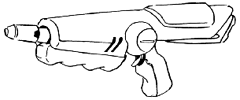 GU-19
SINGLE-BARREL 32MM GUN POD: The GU-19 can fire either in semi-automatic or
fully automatic modes with the later at a rate of 200 rounds per minute.
The weapon is fed from a single 100 round clip inserted into the rear and has
the capability of being reloaded in the field provided additional clips are
available.
GU-19
SINGLE-BARREL 32MM GUN POD: The GU-19 can fire either in semi-automatic or
fully automatic modes with the later at a rate of 200 rounds per minute.
The weapon is fed from a single 100 round clip inserted into the rear and has
the capability of being reloaded in the field provided additional clips are
available.
 (SPACE
HARGUN) GU-11C
THREE-BARRELED 55MM ROTARY GUN POD: A carbine version of the venerable
GU-11 gunpod found on the VF-1. The GU-11C can fire at a cyclic rate of
250 rounds per minute and has an internal capacity of 200 rounds. The
weapon, like the GU-11, can not be reloaded in the field. The ammunition
is high explosive armor piercing although other ammunition types may be fired.
(SPACE
HARGUN) GU-11C
THREE-BARRELED 55MM ROTARY GUN POD: A carbine version of the venerable
GU-11 gunpod found on the VF-1. The GU-11C can fire at a cyclic rate of
250 rounds per minute and has an internal capacity of 200 rounds. The
weapon, like the GU-11, can not be reloaded in the field. The ammunition
is high explosive armor piercing although other ammunition types may be fired.
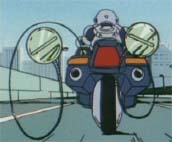 2 x MAGNETIC
GRAPPLES: Both models of the Hargun are outfitting with magnetic
grapples. The grapples can be used either to capture vehicles (as is the
case for the Hargun) or to tie the unit to the exterior of a spacecraft (in
the case of the space Hargun). The grapples have a range of up to 15
minutes can reel the Hargun, or bring the target closer.
2 x MAGNETIC
GRAPPLES: Both models of the Hargun are outfitting with magnetic
grapples. The grapples can be used either to capture vehicles (as is the
case for the Hargun) or to tie the unit to the exterior of a spacecraft (in
the case of the space Hargun). The grapples have a range of up to 15
minutes can reel the Hargun, or bring the target closer.
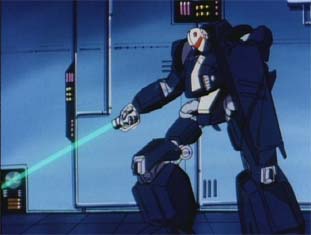 (Optional)
BEAM SABER: Powered by a dedicated protoculture cell, the beam saber is a
magnetically confined 10 eV DT plasma capable of cutting through the hardest
of material. The weapon is stored in a dedicated housing in the right
leg, ready to use if the enemy closes to hand-to-hand combat range. The
weapon proved to be difficult to manufacture and of limited combat ability and
therefore they were normally only issued to officers and/or enlisted personal
in special circumstances.
(Optional)
BEAM SABER: Powered by a dedicated protoculture cell, the beam saber is a
magnetically confined 10 eV DT plasma capable of cutting through the hardest
of material. The weapon is stored in a dedicated housing in the right
leg, ready to use if the enemy closes to hand-to-hand combat range. The
weapon proved to be difficult to manufacture and of limited combat ability and
therefore they were normally only issued to officers and/or enlisted personal
in special circumstances.
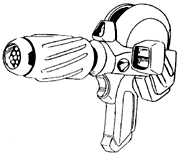 (Optional) N-1
NET LAUNCHER: The N-1 fires 30 square meter net composed of
tungsten-steel filaments. The net is capable of ensnaring small sized
mecha and/or vehicles and has the capability of reeling the net back to the
launcher to fire again (15 seconds).
(Optional) N-1
NET LAUNCHER: The N-1 fires 30 square meter net composed of
tungsten-steel filaments. The net is capable of ensnaring small sized
mecha and/or vehicles and has the capability of reeling the net back to the
launcher to fire again (15 seconds).
DAMAGE:
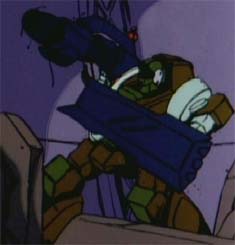 STANDARD EQUIPMENT FOR THE
SPACE HARGUN:
STANDARD EQUIPMENT FOR THE
SPACE HARGUN:
Random Hit Locations
When there is an equal chance of hitting both sides from 1d6
When there is a preferred side, roll 1d10
FRONT BACK SIDES TOP BOTTOM FRONT BACK SIDES TOP BOTTOM
Hargun Motorcycle
Headlight
(Main Body)
01-15
-
01-03
01-05
01-02
Front Tire (Main Body
15-35
01-03
04-15
06-25
03-23
Rear Tire (Main Body)
36-40
04-20
16-30
26-35
24-44
Main Body (Driver)
41-70
21-60
31-70
36-65
45-85
Driver
71-00
61-00
71-00
66-00
86-00
Hargun Battloid
Head (Main Body)
01-05
01-02
01-07
01-15
-
Hands (Arms)
06-09
03-06
08-12
16-17
01-05
Arms (Main Body)
10-30
07-30
13-35
18-40
06-20
Legs (Main Body)
31-50
31-55
36-54
41-50
21-60
Rear Thruster
(Main Body)
-
56-60
54-56
51-60
61-65
Main Body
51-85
61-85
57-80
61-80
66-80
Pilot's Compartment
-
86-87
-
81-85
81-85
Gun Pod (Hands)
86-00
88-00
81-00
86-00
86-00
| Space Hargun |
FRONT |
BACK |
SIDES |
TOP |
BOTTOM |
| Head (Main Body) | 01-05 | 01-02 | 01-07 | 01-15 | - |
| Hands (Arms) | 06-09 | 03-06 | 08-12 | 16-17 | 01-05 |
| Arms (Main Body) | 10-30 | 07-30 | 13-35 | 18-40 | 06-20 |
| Legs (Main Body) | 31-50 | 31-50 | 36-50 | 41-50 | 21-55 |
| Rear Thruster (Main Body) | - | 51-70 | 51-60 | 51-60 | 56-65 |
| Main Body | 51-85 | 71-83 | 61-80 | 61-80 | 66-80 |
| Pilot's Compartment | - | 84-87 | - | 81-85 | 81-85 |
| Gun Pod (Hands) | 86-00 | 88-00 | 81-00 | 86-00 | 86-00 |